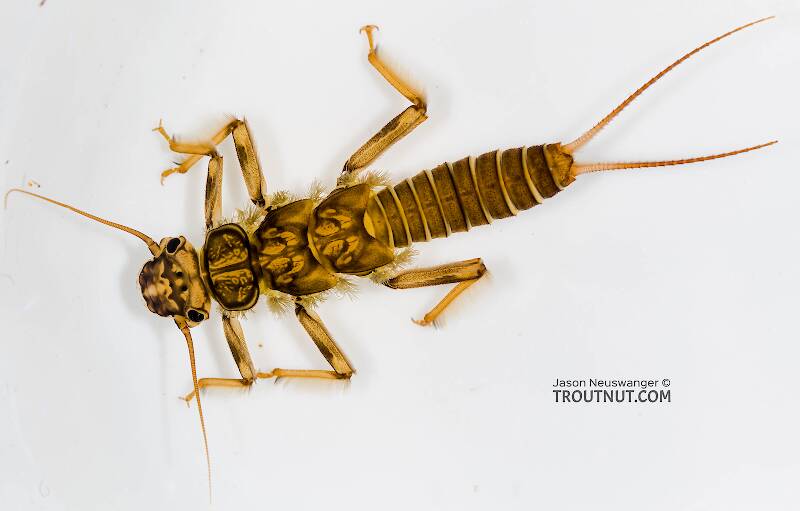
Blue-winged Olives
Baetis
Tiny Baetis mayflies are perhaps the most commonly encountered and imitated by anglers on all American trout streams due to their great abundance, widespread distribution, and trout-friendly emergence habits.

Mayfly Species Habrophlebiodes americana
Species Range
Physical description
Most physical descriptions on Troutnut are direct or slightly edited quotes from the original scientific sources describing or updating the species, although there may be errors in copying them to this website. Such descriptions aren't always definitive, because species often turn out to be more variable than the original describers observed. In some cases, only a single specimen was described! However, they are useful starting points.
Male Spinner
Wing length: 5-5.5 mm
Head and thorax reddish brown. Legs whitish. Fore femur brownish, darker at the apex; hind femur with a dusky apical band and faint indications of a median band. Wings hyaline. Longitudinal veins of the costal margin, and the bases of the other longitudinals, very pale brown. All other veins colorless.
Middle abdominal segments more or less semi-transparent, the venter paler than the dorsum. Tergites obscured with purplish brown markings, on the posterior and lateral margins, the median line, and oblique lateral streaks from the postero-lateral angles. Pale submedian anterior triangles are thus left. Basal and apical tergites opaque, dark red-brown; the apical sternites much paler than the tergites, and with a yellowish tinge. Middle sternites largely pale. Each is marked with a purplish brown band extending transversely across the sclerite from the postero-lateral angle, leaving a narrow median pale space on the posterior margin, and wide pale areas anteriorly. On the apical segments, this band is much reduced in size. Ganglionic areas opaque white on sternites 2-6; on 7-9, marked with pale orange-brown. Forceps base pale brown; forceps yellowish white (see fig. 142). Tails white, narrowly darker at the joinings.
Described as H. betteni
Body length 5.5 mm, wing length 5.5 mm
This is an all-brown mayfly that is pale only on the appendages. Head and thorax shining blackish brown above, a little lighter on the sides. Legs brownish, much paler beyond the knees. Front femora all very dark, the others lighter, obscurely twice banded with blackish. Wings subhyaline with brown longitudinal veins and very faint cross veins. Costal cross veins wanting before the bulla, in the costal area few (7 to 10), simple, oblique, and entire.
Abdomen nearly uniform brown above and below with a pair of obscure, dorsal, basal, paler triangles on each of the middle segments. Prolongation of the 9th sternite deeply divided by a wide V-shaped notch into two rather acutely triangular lobes. Forceps brownish, the main joint triangular lobes. Forceps brownish, the main joint regularly tapering. Penes yellowish with the clavate and divergent reflexed spurs still paler (see fig. 142). Tails pale brown, narrowly ringed with darker brown.
Start a Discussion of Habrophlebiodes americana
References
- Needham, James G., Jay R. Traver, and Yin-Chi Hsu. 1935. The Biology of Mayflies. Comstock Publishing Company, Inc.
Mayfly Species Habrophlebiodes americana
Species Range
Resources
- NatureServe
- Integrated Taxonomic Information System
- Global Biodiversity Information Facility
- Described by Banks (1903)


